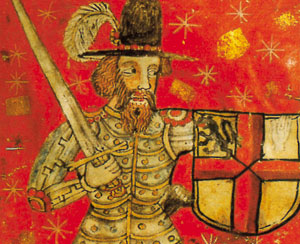KINDRED LINES: How Anglo-Norman names were Hibernicised
Published in Features, Issue 3 (May/June 2019), Volume 27By Fiona Fitzsimons

Above: Richard Mór Mac William de Burgh (d. 1243), who conquered Connacht in 1235. Within a century the name had been completely Gaelicised and had separated into Mac William Burke and Clanrickard Burke. (TCD)
The family names of the military leaders who led the invasion of Ireland in 1169–76—the various ‘Fitzs’, Butler, de Barry, de Bermingham, de Burgh, de Clare, de Courcey, de Lacy, de Montmorency, de Roche, de Prendergast, Tyrrell and de Vernon—are evidence of their complex identity. They were descended from Norman families who had settled for generations in Britain. They formed their names from toponyms (from place-names), patronyms (from the father) and occupations. By the mid-twelfth century, many élite military families had fixed surnames that were passed intact from father to son. These names reveal the process of acculturation in the previous century.
Where family names were formed from toponyms, indicated by the prefix ‘de’ (of), we can distinguish evidence of origins or settlement. In some instances the name reveals the family’s place of origin in France (de Roche, de Courci, de Courtney) or Britain (de Burgh in Norfolk, de Clare in Suffolk, de Barry in Wales). We also find de Cruis, of less certain origin, although it has been suggested that Augustino de Cruis, the progenitor of this name in Ireland, may have been a crusader.
Other Anglo-Norman names indicate occupation, e.g. Butler—in c. 1185 Theobald Walter was appointed ‘Butler of Ireland’. Other occupations from which surnames were derived include Marshall and possibly Ussher.
The Geraldines, probably the most enduring of all military families involved in the conquest, used patronyms, indicated by the prefix ‘fitz’ (from the French fils, ‘son of’). These names changed in every generation, until a ‘founder’s name’ was instituted as a fixed surname.
In 1169 Maurice Fitz Gerald, a battle-hardened veteran, was part of the first invasion force. We can trace his descendants to the Fitzgeralds, earls of Kildare and Desmond; the Knights of Glin (Fitzgerald); the Knights of Kerry (Fitzmaurice); and the White Knight (Fitzgibbon). Raymond le Gros (‘the fat’), whose moniker delighted generations of schoolchildren, was also a Geraldine. His descendants became the Carews of Cork and Mayo.
Settlement in Ireland added a new layer to Anglo-Norman identity. In successive generations, the head of the family usually tried to maintain a close link to Norman barons in England and Scotland. The cadet branches of these families kept a local focus and rapidly Gaelicised, modifying their names. The de Burghs, lords of Connacht and earls of Ulster, relied on their Gaelicised de Búrca kinsmen to govern their territories. After 1332 de Burgh Irish territories were carved up by competing interests, the Mac William Burkes and the Clanrickard Burkes.
The conquerors brought in administrators and settlers to realise the wealth in the land. Some of these families were Norman (Fagan), some were English (Fitzsimons) and some were taken from ethnic groups within Norman territories (Fleming, Welsh). In Ireland they became closely associated with the colony. By the sixteenth century they were indistinguishable from the other families of the ‘Old English’ community.
Integration also affected the Irish, and ranged in degree from adopting Anglo-Norman forenames (Seán and Uilliam) to the full assimilation of families such as Shee in Kilkenny and the merchant families of Morphy in Wexford and Joyce in Galway. It’s possible that Anglo-Norman acculturation happened as fast as it did in Ireland because the invaders understood the benefits of adapting to the society conquered.
Fiona Fitzsimons is a director of Eneclann, a Trinity campus company, and of findmypast Ireland.
















